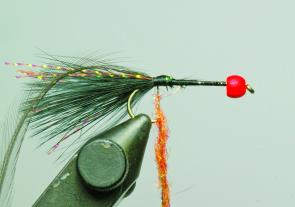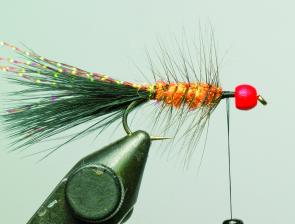The Woolly Bugger is no doubt a variation of the Woolly Worm, which started to appear in the fly boxes of USA anglers sometime in the 50’s.
The Woolly Worm itself was an adaption of the British palmer fly that dates back to the days of Walton. Both the bugger and the worm flies were developed in the USA and were originally tied to be crappie, panfish and bass flies.
At one time or another both these flies would be in the top ten favourite flies from many anglers the world over, it was once suggested that this fly was so successful that it was to be banned from some catchments. It is still an extremely popular and effective fly these days, and the variations in both tying styles and materials are too many to list.
Here in Australia its popularity is not as it once was, except of course for Tasmania were it is as popular as ever, and a dynamic fish taker. Its variations and variants are still used from the smallest mountain streams and tarns right down through the rivers and lakes and finally to the estuaries where it accounts for some lunking sea run trout.
As mentioned the variations are endless, different colours and tying styles to suit the different seasons, this particular tie is a late season version that mimics the vibrant colours of autumn. The coloration also makes it a particularly effective pattern to use around river mouths on lakes for the congregations of fish that begin to gather there in late autumn.
It is however just as effective on the lower sections of these inflowing streams as these congregations begin to move upstream. This style of fishing is not everyone’s cup of tea, but as long as appropriate fishing practices are observed some fantastic sport and fantastic fish can be had.
This fly can be tied to imitate, baitfish, tadpoles, small yabbies, and even snails if tied unweighted on smaller hooks and fished inert. The vast majority of styles of this fly are tied on longer shanked hooks, but again the hook type, tying style and fishing method are up to the fly’s creator.
I recall a trip to the central highlands of Tasmania one February where I used a small black version of this fly in a howling blizzard on Lake Kay. There was a massive dun hatch in progress, and it was hard to pick the slashing rises from the white caps on the lake.
Not being as adventurous as my fishing partner who was wading out in the middle, I chose the safer option of slowly working the edges, and casting the fly to cruising fish along the edges with great success. A very versatile fly indeed.
Facts
TYING INSTRUCTIONS and MATERIALS
| HOOK: | Mustad R72LS # 6-14 |
|---|---|
| THREAD: | Black UTC 70 denier |
| BODY: | Hot orange seals fur or an equivalent synthetic. |
| COLLAR: | Black cock hackle |
| RIB: | As above |
| TAIL: | Black marabou, with strands of orange crystal flash. |
| HEAD: | Hot orange bead, (optional) |

Slide the bead onto the hook and run up to behind the hook eye. Attach the thread and wind to the bend of the hook. Tie in the marabou tail and several stands of crystal flash either side of the marabou.

Tie in a black cock hackle feather by the tip, and then apply the dubbing to the thread.

Wind the dubbing on to just behind the orange bead, leaving sufficient space to wind on the collar.

Now wind on the ribbing hackle, brushing the fibres back as you wind it on in evenly spaced turns.

Tie in the collar hackle and take 3-4 turns holding the hackle fibres back as you make each turn. Then whip finish behind the bead.

Take a dubbing brush and give the bugger a good brushing, stroking the fibres back towards the tail




